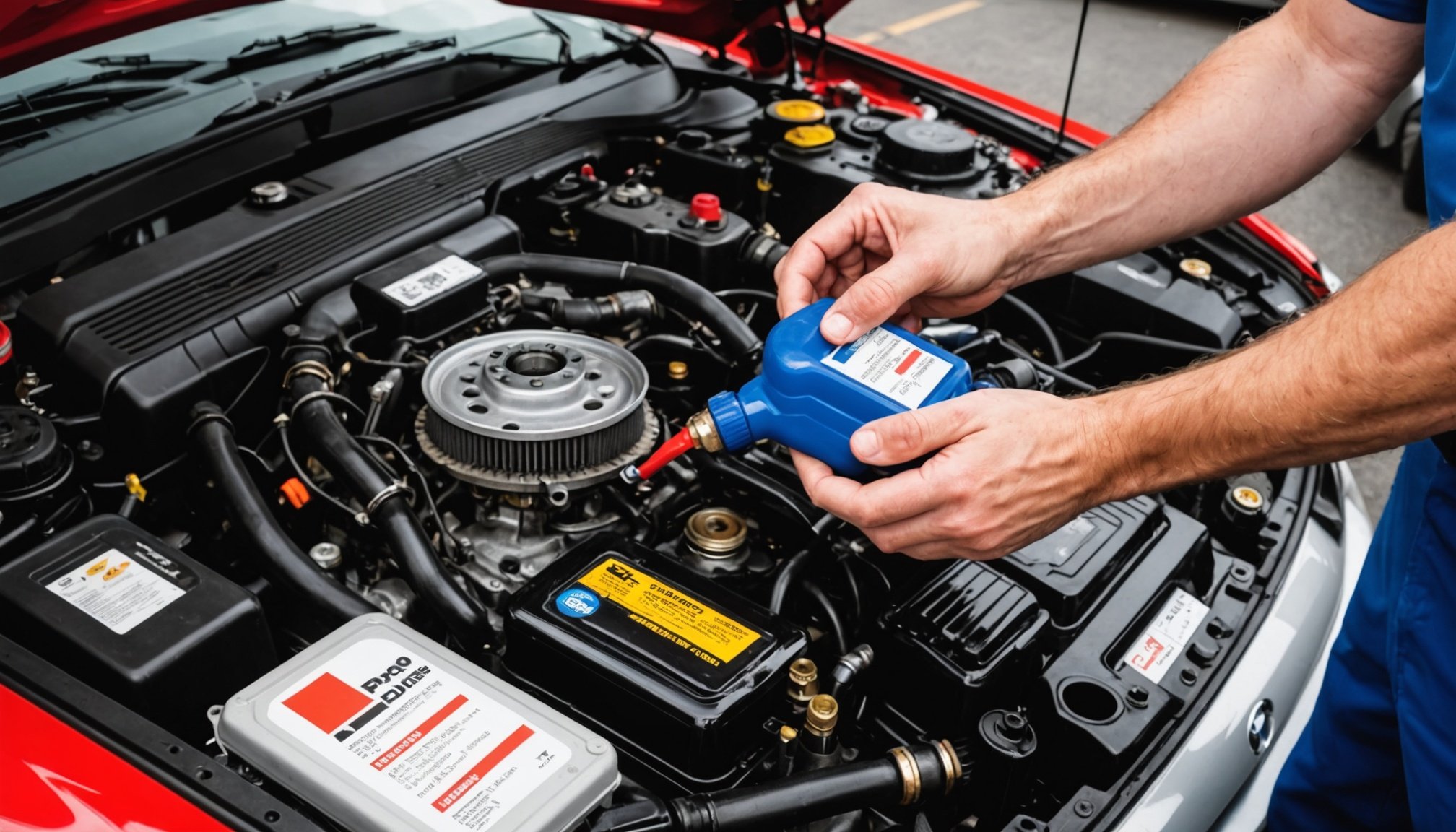Ultimate Handbook for Flushing Transmission Fluid in Your British Performance Vehicle: Pro Techniques for Superior Outcomes
Understanding the Importance of Transmission Fluid
When it comes to maintaining your British performance vehicle, whether it’s an Audi with a DSG transmission or any other high-performance model, the transmission fluid plays a crucial role in ensuring smooth gear changes, optimal vehicle performance, and overall engine health. Transmission fluid is more than just a lubricant; it acts as a hydraulic fluid, a heat transfer fluid, and a protective agent for the internal components of your transmission.
“Transmission fluid is the lifeblood of your transmission. It lubricates, cools, and protects the internal components from wear and tear,” explains a mechanic from All Drive Transmission[4].
Additional reading : Essential tips to extend your british plug-in hybrid”s battery life: proven strategies for optimal performance
Identifying When to Flush Your Transmission Fluid
Knowing when to flush your transmission fluid is essential to prevent issues such as harsh shifting, slippage, and overheating. Here are some signs that indicate it’s time for a transmission fluid flush:
- Unusual Noises: Grinding or whining sounds from the transmission area.
- Delayed Shifting: If your vehicle is taking longer than usual to shift gears.
- Slippage: If the transmission is slipping or hesitating during gear changes.
- Overheating: If the transmission temperature light is on or if you notice a burning odor.
- Fluid Condition: If the fluid appears dark or has a burnt smell[2][4].
Preparing for the Flush Process
Before you start the flush process, it’s crucial to gather the right materials and understand the specific requirements of your vehicle.
Also to discover : Expert tips for effortlessly installing a panoramic camera system in your luxury british car
Materials Needed
- Transmission Fluid: High-quality fluid recommended by your vehicle’s manufacturer.
- Flush Kit: A transmission flush kit specific to your vehicle model.
- Funnel: To pour in the new fluid without spilling.
- Rags: To clean up any spills.
- Owner’s Manual: For specific instructions and recommendations.
Vehicle-Specific Considerations
- Check Your Owner’s Manual: Ensure you have the correct type and amount of transmission fluid required for your vehicle. For example, if you have an Audi with a DSG transmission, you’ll need to use the recommended fluid type to avoid any compatibility issues[3][4].
Step-by-Step Guide to Flushing Transmission Fluid
Flushing your transmission fluid is a multi-stage process that requires careful attention to detail. Here’s a step-by-step guide to help you through it:
Stage 1: Warm Up the Engine
- Start your engine and let it run for about five minutes to warm up the transmission fluid. This helps the fluid to circulate and makes it easier to drain.
Stage 2: Locate the Transmission Pan
- Refer to your owner’s manual to find the location of the transmission pan. It is usually located at the bottom of the transmission and may be held in place by bolts or clips.
Stage 3: Drain the Old Fluid
- Use a socket wrench to remove the bolts holding the transmission pan. Be prepared for the fluid to drain out quickly, so have a drain pan in place.
- Once the fluid has stopped dripping, replace the transmission pan and tighten the bolts securely.
Stage 4: Add New Fluid
- Use a funnel to pour in the new transmission fluid. Ensure you add the correct amount as specified in your owner’s manual. For most vehicles, this ranges from 12 to 16 quarts (11.3 to 15.1 liters)[2].
Stage 5: Check Fluid Levels
- Start the engine again and let it run for a few minutes. Then, turn off the engine and check the fluid level using the dipstick. The level should be between the cold and hot markings on the dipstick.
Using Transmission Fluid Additives for Enhanced Performance
In addition to regular flushing, using transmission fluid additives can significantly improve the performance and longevity of your transmission.
LUBEGARD Platinum ATF Protectant
- This additive can be used with any ATF (except CVT and Ford Type F pre-1986) to restore additive content, eliminate torque converter shudder, and enhance frictional stability. It uses proprietary LXE® and Synergol® technologies to improve heat conductivity and reduce transmission operating temperatures[1].
Hot Shot’s Secret Shift Restore
- This additive is designed to dissolve gum and varnish on transmission components, lubricate and protect key parts, and reduce friction. It is recommended to use approximately 1.5 oz of Shift Restore per 1 qt of transmission fluid[5].
Tips for Maintaining a Healthy Transmission
To ensure your transmission remains in top condition, here are some additional tips:
Regular Fluid Checks
- Check the transmission fluid level and condition regularly. If the fluid appears dark or has a burnt smell, it’s time for a change[4].
Smooth Driving Habits
- Avoid aggressive driving habits such as sudden acceleration, harsh braking, and rapid gear shifts. Smooth and gradual acceleration and deceleration can significantly reduce strain on the transmission[4].
Conditional Service
- Follow your manufacturer’s recommendations for fluid changes and other maintenance tasks. This can prevent overheating, reduce friction, and extend the lifespan of your transmission[4].
Common Issues and Solutions
Here are some common issues you might encounter with your transmission and how to address them:
Harsh Shifting
- Cause: Worn-out fluid or incorrect fluid type.
- Solution: Change the transmission fluid to the recommended type and consider adding a transmission fluid additive like LUBEGARD Platinum ATF Protectant[1].
Overheating
- Cause: Low fluid levels or poor fluid quality.
- Solution: Check and top off the fluid levels, and ensure the fluid is of high quality. Consider a transmission flush if the fluid is old or contaminated[2][4].
Slippage
- Cause: Incorrect fluid type or worn-out clutch packs.
- Solution: Use the correct fluid type and consider a transmission flush. If the issue persists, it may be necessary to replace the clutch packs[3].
Flushing your transmission fluid is a critical maintenance task that can significantly improve the performance, fuel efficiency, and overall health of your vehicle. By following the steps outlined in this guide, using the right materials, and adopting good driving habits, you can ensure your British performance vehicle runs smoothly and efficiently.
“Regular maintenance is key to extending the life of your transmission. It’s not just about changing the fluid; it’s about ensuring every component is well-lubricated and protected,” advises a mechanic.
Practical Insights and Actionable Advice
Here are some practical insights and actionable advice to keep in mind:
- Use High-Quality Fluid: Always use the transmission fluid recommended by your vehicle’s manufacturer to ensure optimal performance and to avoid any compatibility issues.
- Check Fluid Levels Regularly: Regular checks can help you catch any issues early, preventing major repairs down the line.
- Drive Smoothly: Avoid aggressive driving habits to reduce strain on the transmission.
- Consider Additives: Transmission fluid additives can enhance the performance and longevity of your transmission.
Detailed Bullet Point List: Steps for Flushing Transmission Fluid
-
Warm Up the Engine:
-
Start the engine and let it run for about five minutes.
-
Ensure the transmission fluid is warm and circulating.
-
Locate the Transmission Pan:
-
Refer to your owner’s manual for the location.
-
It is usually at the bottom of the transmission.
-
Drain the Old Fluid:
-
Remove the bolts holding the transmission pan.
-
Be prepared for the fluid to drain out quickly.
-
Replace the transmission pan and tighten the bolts securely.
-
Add New Fluid:
-
Use a funnel to pour in the new transmission fluid.
-
Ensure the correct amount is added as specified in your owner’s manual.
-
Check Fluid Levels:
-
Start the engine and let it run for a few minutes.
-
Turn off the engine and check the fluid level using the dipstick.
-
The level should be between the cold and hot markings.
Comprehensive Table: Transmission Fluid Requirements for Common British Performance Vehicles
| Vehicle Model | Transmission Type | Fluid Type | Fluid Capacity (Quarts) |
|---|---|---|---|
| Audi DSG | Dual Clutch | Synthetic ATF | 12-14 |
| BMW ZF | Automatic | Synthetic ATF | 13-15 |
| Jaguar 8-Speed | Automatic | Synthetic ATF | 14-16 |
| Land Rover 9-Speed | Automatic | Synthetic ATF | 15-17 |
| Mini Cooper DCT | Dual Clutch | Synthetic ATF | 10-12 |
Quotes and Anecdotes
-
“I once had a client who neglected to change their transmission fluid for over 100,000 miles. The result was a complete transmission failure that cost them thousands to repair. Regular maintenance is crucial,” shares a mechanic from All Drive Transmission[4].
-
“Using the right transmission fluid can make a world of difference. I’ve seen vehicles go from harsh shifting to smooth, seamless gear changes just by switching to the recommended fluid type,” says an Audi technician.
By following this ultimate handbook, you’ll be well-equipped to maintain your British performance vehicle’s transmission, ensuring a smooth driving experience, high performance, and optimal fuel efficiency. Remember, regular maintenance is key to extending the life of your transmission and preventing costly repairs.











